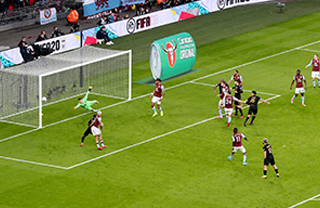
How closely do your practices replicate the ‘real’ game?
- Peter Glynn
- 15 June 2020
Players improve through purposeful practise that replicates the demands of the game. But what does the ‘real’ game look like and how can you ensure your practices replicate it?
Breaking the game down into individual player skills and tactics, unit relationships and team structure is helping candidates on The FA’s UEFA A Licence course develop their game knowledge.
Putting individual players ‘under the microscope’ - as shown in the video above - is challenging coaches to develop their knowledge of individual player skills and tactics.
The process, which uses a quadrant tool to guide coaches’ observation skills, aims to support coaches in designing and delivering more realistic practice sessions.
“Practices should replicate what’s happening on a gameday - otherwise what’s the point? So, we ask the candidates to study the footage, and start to think about their own practice design,” explains Phil Church, FA national coach developer and tutor on the A licence and UEFA Pro Licence courses.
A ‘narrow focus of attention’ and looking away from the ball

Key to the process is effective observation. Having a narrow focus of attention and looking away from the ball can improve coaches’ knowledge of the game, explains Church.
“In each clip we show on the course, we try to only focus on one player, or unit or part of the game, because in any moment there will be so many other things going on.
“When you’re watching a game or a practice you’re instinctively drawn to the ball. But, actually, what a coach needs to focus on is away from the ball.
“For example: a centre-half will be reacting off what’s happening at the other end of the pitch with the ball.
“But they will also be dealing with what’s happening with the movement of the centre forward that is nowhere near the ball.
“The forward might be dropping, the defender might want to go with the attacker or they might not. The defender might let the attacker run offside – there’s so much going on away from the ball that impacts upon what happens.”
How to understand the ‘key pictures’

As coaches move on from looking at individual player skills, graphical overlays and annotation are used to help develop knowledge of overall team structure and relationship between units.
“Through the telestration and information overlaid on the footage, candidates can quickly see: where the ball is, the number of players in certain areas of the pitch, the distances between players, the positioning of the opposition and lots of other things,” explains Church.
“It’s brilliant for session design and really showing candidates this is what the elite game looks like.”
Much of this content is now publicly available through FA Learning’s YouTube channel which has been used to support coaches through the lockdown period.
Ensuring the right area-sizes, player positions, start-points and realistic movements linked to a session theme can be a challenging process.
“Sometimes we’ll see sessions for parts of the game that have the wrong players included,” explains Church.
“Or, it might be that the coach has an overload when the footage is showing us that more often than not that part of the game isn’t overloaded. Or the session is underloaded when it’s not underloaded.”
Realistic practice design: 5 attackers versus 10 defenders
During last season’s FA Cup tie between Wolves and Manchester United, Nuno Espirito Santo’s side used a low-block strategy.
“In one of the clips, Wolves are defending with all of their players in an area 16 metres by 30 metres,” explains Church.
“Within that, United have got five attackers against them in that area. So that’s 10 outfield players versus five.
“On a really superficial level: 10 defenders versus 5 attackers, 10 yards outside of the box - that’s the start of a practice design”.
Delivering detail in an appropriate way

Delivery of the technical and tactical information is not overlooked. Translating technical and tactical detail for the age and stage of the players that coaches work with is a crucial part of the process.
“Coaches must have the technical and tactical knowledge, but they also have to have the social and psychological understanding which is vital,” explains Church.
“How they deliver the information must be based on the needs of individuals and the group they work with.
“They might understand their players really well and their learning preferences. They might know that the players prefer a certain type of interaction, such as not wanting to be stopped a lot on the pitch.
“The approach to delivering technical and tactical content has to be based on individual needs. If it’s player development in youth football then that might be a really key approach.
“However, for coaches working in first-team football then there may be times that it’s part of someone’s philosophy to actually say: ‘I’m going to tell you this because this is key. We want you to have this information, so we’re going to give it to you’.”
To learn new skills and to enhance your technical and tactical knowledge, visit our webinar playlist on YouTube.
Article image courtesy of Andrew Fosker/BPI/Shutterstock.


